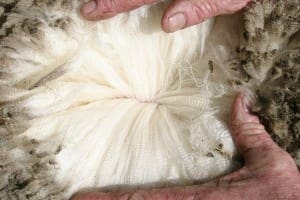 RECENT gross margin analysis of wool and prime lamb operations is predicting stellar profits for fine wool growers in western Victoria and across Australia at current auction prices.
RECENT gross margin analysis of wool and prime lamb operations is predicting stellar profits for fine wool growers in western Victoria and across Australia at current auction prices.
The latest Grassgro analysis done by Hamilton Agrivet Business Consulting principal Graham Lean shows that fine wool has returned to pre-eminence, with a gross margin of $59 per Dry Sheep Equivalent compared to $38/DSE for prime lamb production.
Dr Lean said the key reason for Grassgro modelling predicting such a bright future for wool is that prices are back to longer term averages or better for superfine wools.
“But on top of this, unlike 10-15 years ago, there are also high livestock trading (meat) profits adding to the cream, and that is why GrassGro is predicting such good profits based on longer term or current prices for Merinos.”
Dr Lean said similar results could be expected with fine wool sheep across Australia, with most Merino flock owners having moved toward finer wool production.
“Most of Australia has moved toward those finer sheep.”
Wool also set to top grain
Dr Lean said on current prices fine wool returns are also way ahead of cropping returns in medium rainfall areas such as Lake Bolac, also a strong grain and oilseed production area. Estimated fine wool gross margin returns of $885/ha compare to prime lamb returns of around $570/ha, cereals at $250/ha and good canola production returns of about $500/ha.
“The well-drained soil types of the Lake Bolac district mean that these gross margins will be well in front of cropping gross margins in other districts with soil types prone to waterlogging, which is common through a lot of western Victoria.”
Dr Lean said his latest Grassgro comparison of wool and prime lamb gross margins is based on data from average wool and prime lamb enterprises in Agriculture Victoria’s farm monitor project. Fine wool flock assumptions include an AWEX Eastern Market Indicator of 1546c/kg clean, with an average 18.4 micron flock wool cut of 5kg greasy and a 75 percent lamb marking rate. Prime lamb flock assumptions include an Eastern States Trade Lamb Indicator at 611c/kg cwt with 487 kg/ha liveweight of lamb produced and a marking rate of 120pc. The mutton price for both enterprises is 400c/kg cwt for cast for age sheep.
The latest simulation shows how dramatic the turn-around in wool’s prospects has been, and how important meat returns are, even to a fine wool operation, with the comparative 2015-16 farm monitor results for wool at $18/DSE versus $31.92/DSE for prime lambs in western Victoria.
Dr Lean said livestock trading in these simulations equates to $20/DSE, whereas 20 years ago it was $1-$2/DSE and even 10 years ago it was only $5-10/DSE.
“This is why profitability of a wool operation is at historical highs on these figures, yet wool prices in real terms are nowhere near what they were in the late 1980s.”
The 2016-17 Grassgro GM/DSE simulation are the highest for fine wool since 1987-88 when wool at $55.01/DSE also surpassed prime lambs at $45.54 among farm monitor project participants. But the recent record fine wool and sheep meat prices still doesn’t put expected fine wool margins close to those of 1972-73, when the comparative wool-prime lamb GM/DSE figures were $76.74/$72.55.
Click here to see a graph of the historical $GM/DSE performance of average wool and prime lamb enterprises in the South West Victorian Farm Monitor Project.
Long term analysis shows wool also ahead
Dr Lean’s long term analysis of fine wool and prime lamb operations in south-west Victoria, using Grassgro to analyse average livestock monitor project data, also puts a fibre-based operation ahead of meat on a gross margin basis on average over the last 15 years. Using 15 year real wool prices, 10 year real meat prices, 55 years weather data and physical characteristics of average wool and prime lamb enterprises from the South West Victorian Farm Monitor Project, wool is $6/DSE ahead in a high rainfall area and marginally in front in medium rainfall conditions. This is in comparison to the actual performance over the last three years or so, where wool hasn’t performed as strongly on the benchmarking figures.
“I think this is most likely due to the Merino operations being predominantly only to the north of Hamilton (or north of Glenelg Highway) and taking it more in the neck from poor seasons over the last few years.
“This has an impact on production (and hence profit) and also causes increased supplementary feeding and labour (feeding etc) and hence higher costs that impact on profit,” Dr Lean said.
Click here to see the long-term (15 year) Grassgro analysis of average farm monitor enterprise gross margins per DSE.
Management not enterprise is the key
Dr Lean said the biggest profit driver for wool or meat operations is management not enterprise choice.
“Enterprise choice is not a key profit driver.
“There is more variation within enterprises than between them,” he said.
“Do what you enjoy, suits your farm, climate and management and most importantly, continually improve enterprise performance.
“Don’t chop and change between enterprises and don’t run too many of them as it complicates efficient management without reducing risk. In fact, it increases it.”
Mercado’s Rob Hermann will outline the latest Grassgro analysis by Dr Lean at the Balmoral Sire Evaluation Group’s annual field day at Harrow today. The field day starts at noonat Tuloona with an inspection of 50 Merino sire progeny groups. Other guest speakers will be Australian Wool Innovation’s Marius Cuming and Achieve Ag Solutions’ Nathan Scott. There will also be a panel discussion about the Merino Lifetime Productivity Project.



What this means is that prime lamb producers need to significantly lift their marking percentages to compete.